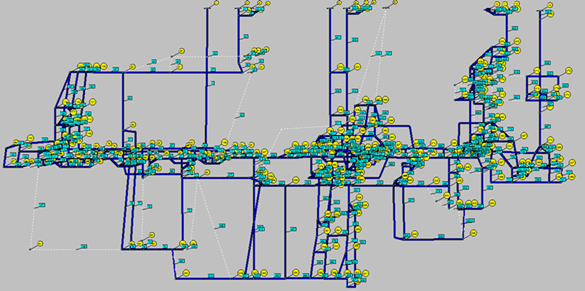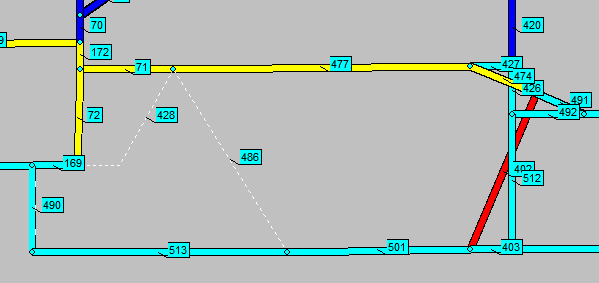Abstract
Content
- 1. Aims and objectives of the Master’s thesis
- 2. Relevance of the work
- 3. Expected scientific innovation
- 4. A summary of the Master’s thesis
- 5. Conclusion
- References
1. Aims and objectives of the Master’s thesis
The purpose of master's thesis is researching the stability of the air flow at fires in the slope of the descending and ascending ventilation at the mine named after A. Skochinskogo.
In this work are solving the following tasks
- developing a computer model of mine ventilation network;
- calculation of normal and emergency air distribution;
- select all developments that fall into fire gases (the definition of the zone distribution of fire gases in the initial stage of the fire and after the violation of the stability of ventilation);
- determination of areas of possible rollover air flow;
- search for possible siting of the ventilation controls;
- determination of aerodynamic parameters of the ventilation controls and verification of their effectiveness;
- development of measures to improve the stability of ventilation in the slope at fires.
2. Relevance of the work
According to Safety rules at coal mines
. [1] and Recommendations for the choice of efficient modes of mines ventilation during accidents
[2] at the mines of Ukraine during the preparation of emergency response plans should be assessed on a firm downward ventilation of mine workings under exogenous fires. Such an assessment is conducted twice during a year within preparing a new plan for an emergency.
3. Expected scientific innovation
The first time was researched ventilation stability during a fire in inclined workings after general mining reversal of ventilation in conditions of the mine named after A. Skochinskogo. During of special researches performed:
- simulation of general mining reverse ventilation;
- selecting of sites for the ventilation controls installing;
- determination of the aerodynamic resistance of regulators;
- test for effectiveness of the developed activities.
4. A summary of the Master’s thesis
Research of mine workings ventilation stability in the mine named after A. Skochinskogo during fires in the normal and reverse modes of ventilation
In this master's work will be performed research of air flows stability during fires in inclined workings of top–down and bottom–up ventilation. Researches of stability will be conducted by using the program complex IRS Ventilation PLD
. (plan to liquidations to damages).
The first phase of work involves creating a computer model of the mine ventilation network and its testing [5, 6]. The second phase will focus on the modeling of fires in inclined workings and analysis of simulation results. During the third phase will be developed measures that help to improve ventilation stability. Researches include searching of installation sites for air regulators to enhance ventilation flows stability, determination of the aerodynamic resistance and checking the effectiveness of the proposed activities on a computer model.
A feature of this work will be simulation of fires in inclined workings included to the zone of general mining reverse ventilation. In Ukrainian mines determination of ventilation flows stability in the reverse mode ventilation is not provided. However, analysis of the possible consequences allows to suggest that during a fire in the working with downflow and the subsequent reversal of resistance may prevent ventilation stability. In these cases, appears an additional threat to the life of miners and rescuers. Modeling of reverse mode ventilation will be conducted by a special technique developed at the Department of Occupational safety and aerology
DonNTU [4, 7].
In the master's work on a computer model of the mine named after A. Skochinskogo was assessed air flow stability in the workings with top–down and bottom–up ventilation for normal and reverse modes of ventilation.
In the course of the work was developed a computer model of the mine named after A. Skochinskogo (Figure 1). The model consists of 491 ventilating knots and 733 branches.

Figure 1 – Computer model of mine named after A. Skochinskogo
Defined zones spread of fire gases in the normal and reverse modes of ventilation.
Defined workings in which occurred air flow overturning and were analyzed conditions under which happened these rollovers.
Examples of simulation of fires:

Figure 2 – Simulation of a fire in the working with a descending ventilation

Figure 2 – Simulation of fire in the working with ascending ventilation in case of general mining reversed ventilation (animation – 7 frames, 5 cycles of repetition, 140 kilobytes; red – emergency working, yellow – zone of fire gases spread before air flow rollover, blue – zone fire gases spread after air flow rollover. )
5. Conclusion
At the present time in the master's work the technique of definition of a thermal depression of a fire is developed, the computer model of mine named after A. Skochinskogo is developed, the database consisting of graphic and numerical information is prepared. Further researches of stability of airing of developments with descending and ascending airing and an assessment by results of modeling will be conducted.
References
- Правила безопасности в угольных шахтах. – К.: Держохоронпраці. – 2005. – 398 c.
- Рекомендації по вибору ефективних режимів провітрювання шахт при аваріях// НДIГРС. – Донецьк. – 1995. – 165 с.
- Болбат И.Е., Лебедев В.И., Трофимов В.А. Аварийные вентиляционные режимы в угольных шахтах – М.: Недра, 1992 г.,– 204 с.
- Трофимов В.О., Л.В. Незамова. Компьютерне моделювання аварійних вентиляційних режимів. Вісті Донецького гірничого інституту: Всеукраїнський науково–технічний журнал гірничого профілю/ Донецьк: ДонНТУ, 2009. – № 2 – С. 97–100.
- Каледіна І.О., Романченко С.Б., Трофимов В.О. Комп'ютерне моделювання шахтних вентиляційних мереж: Методичні вказівки. – М.: Видавництво МГГУ. 2004. – 72 с.
- Каледіна І.О., Романченко С.Б., Трофімов В.О., Горбатов В.А. Комп'ютерне моделювання задач протиаварійного захисту шахт: Методичні вказівки. – М.: Видавництво МДГУ. 2004 – Частина 1. – 45 с.
- Трофимов В.О., Булгаков Ю.Ф., Кавєра О.Л., Харьковий М.В. Аерологія шахтних вентиляційних мереж. – Донецьк, 2009. – 87 с.
- Матеріали III міжнародної науково–практичної конференції. Вентиляція підземних споруд та промислова безпека у ХХІ столітті. – Донецьк: Доннту. – 2013 – С. 50–53.
